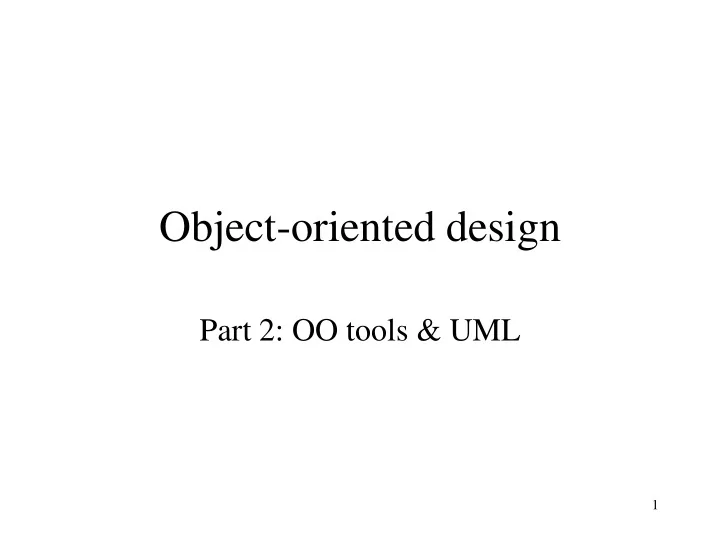

Object-oriented design Part 2: OO tools & UML 1
CRC cards • Design tool & method for discovering classes, responsibilities, & relationships • Record on note card: – class name & purpose – general responsibilities – name(s) of class(es) this class depends on to fulfill its responsibilities 2
Why use cards? • Could record this information using paper, whiteboard, etc. • Advantages of cards: – portable: can easily group & rearrange cards to illustrate/discover relationships between classes – disposable: easily modified or discarded as design changes 3
Example CRC card for ATM • Don’t have to list collaborators on Class : ATM (performs financial services for a bank customer) same line as Responsibilities Collaborations responsibilities - but • create & initialize Transaction doesn’t hurt to do so transactions • This class is unusual • display greeting User Message • display main menu Menu for two reasons: • tell cancel key Cancel Key – large # of to reset responsibilities • check for a cancel Cancel Key – fulfills all • eject receipt Receipt Printer responsibilities via • eject bank card Bank Card Reader collaboration 4
More ATM examples Class : Account (represents account in bank database) Responsibilities Collaborations • Know account balance • Accept deposits • Accept withdrawals Class : Transaction (performs financial service & updates account) Responsibilities Collaborations • Execute financial transaction • Gather information Menu, Form, User Message • Remember data relevant to transaction • Commit transaction Account to database • Check to see if cancel key Cancel Key 5 has been pressed
Some notes on CRC cards • Cards are meant to be transitory tools for proposing designs • Meant as discovery tool, not archival information • For design documentation, use UML diagrams accompanied by explanatory text 6
Intro to UML • UML: unified modeling language • System for graphically representing & manipulating an object-oriented software system • Both a representation of design & tool to assist in design process 7
Class Diagram • 3 parts: class name, attribute, methods - generally listed in that order • Don’t have to list all attributes or methods - usually just the most important • For some diagrams, especially those depicting relationships among classes, can omit all but the class name 8
Attributes • Attributes generally correspond to data members of a class • Can include the following information in a class diagram: – access designation: + means public - means private # means protected – name – data type 9
Methods in Class Diagram • Constructor – special method with same name as class – has no return type & no access designation • Other methods – access designation (+ or -) – method name – parameter list, if needed - in parentheses – return type after colon 10
Example: playing card class Class name } Attributes Methods 11
Example from ATM 12
Depicting class relationships • Relationships between classes are represented by lines between (abbreviated) class diagrams • Line type (solid vs. dotted) and arrowhead type distinguish between various kinds of relationships 13
Aggregation • Aggregation is used when a class is made up of class components – For example, a car has an engine, an electrical system, etc. – A stereo has a receiver, a CD player, speakers, etc. 14
Aggregation & UML • Aggregations are represented with diamond-headed lines connecting an aggregate class to its components • The diamond is at the aggregation end • Can use multiplicity notation to depict the number of instances of each component 15
ATM Example Although we didn’t choose to model it this way, an ATM can be thought of as an aggregate of several things, for example, display device, keypad, deposit slot, receipt printer and bank card reader 16
Multiplicity notation • A number or symbol near either end point of a connecting line indicates multiplicity • Common notations include: – 0 or more: * – 1 or more: 1 .. * – 0 or 1: 0 .. 1 – exactly 1: 1 17
Multiplicity examples From voice mail system: a message queue can contain several messages JukeBox: A SongList (songs picked by an individual user) can have 1- 4 songs, depending on the amount of money deposited; the PlayList consists of all the SongLists queued up as other users’ songs are played 18
Associations • Represent services provided between classes - a.k.a. collaborations • Association is represented by a line between client & server class diagrams • There is no indication of direction of flow of service 19
Associations • Can add role designations to lines in association • Helps clarify bidirectional relationship before a final decision is made about which class actually manages the pertinent information 20
Association Example from ATM Contracts supported: 1. Access & modify account balance 2. Commit results to database 3. Execute a financial transaction Each line represents a collaboration: • ATM collaborates with transaction in fulfillment of ATM responsibility: create & initiate transactions • Transaction collaborates with Account in fulfillment of transaction responsibility: commit transaction to database • Various transaction types collaborate with Account to perform their responsibilities 21
Notes on Graph Complexity • Diagram needs to depict system, but also needs to be readable • All collaborations could be represented on a single association graph, but in a complex system the diagram would be so complicated as to be unusable 22
Notes on Graph Complexity • Best approach is to create multiple diagrams that represent collaborations in fulfillment of a single contract or set of related contracts • Previous example represented all collaborations in support of 3 contracts 23
Inheritance • UML represents inheritance relationships between classes as a line beginning from a subclass diagram and ending in an arrow pointing to the superclass • Abstract classes are represented using {} around their names 24
Example from ATM Design 25
Recommend
More recommend